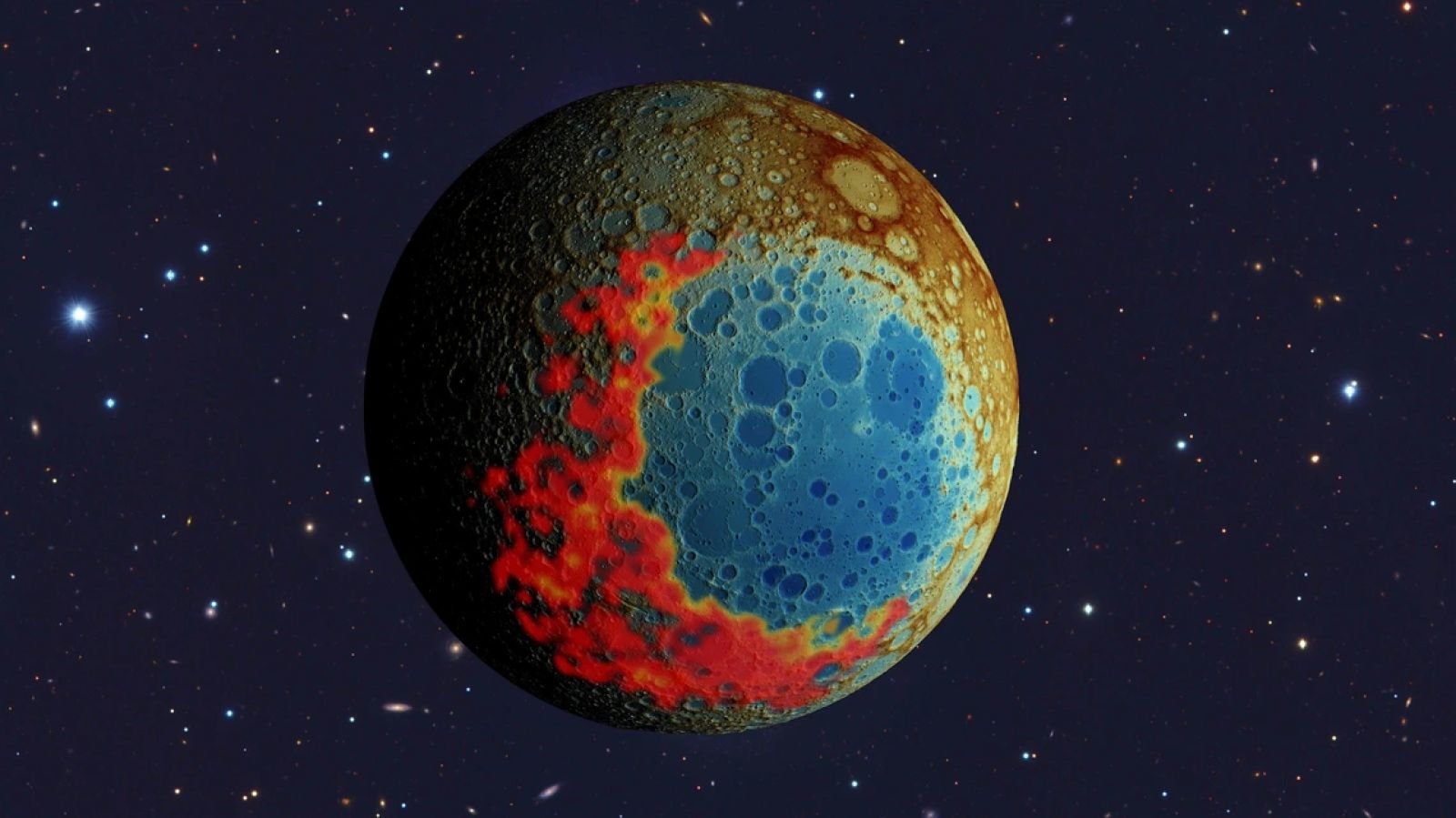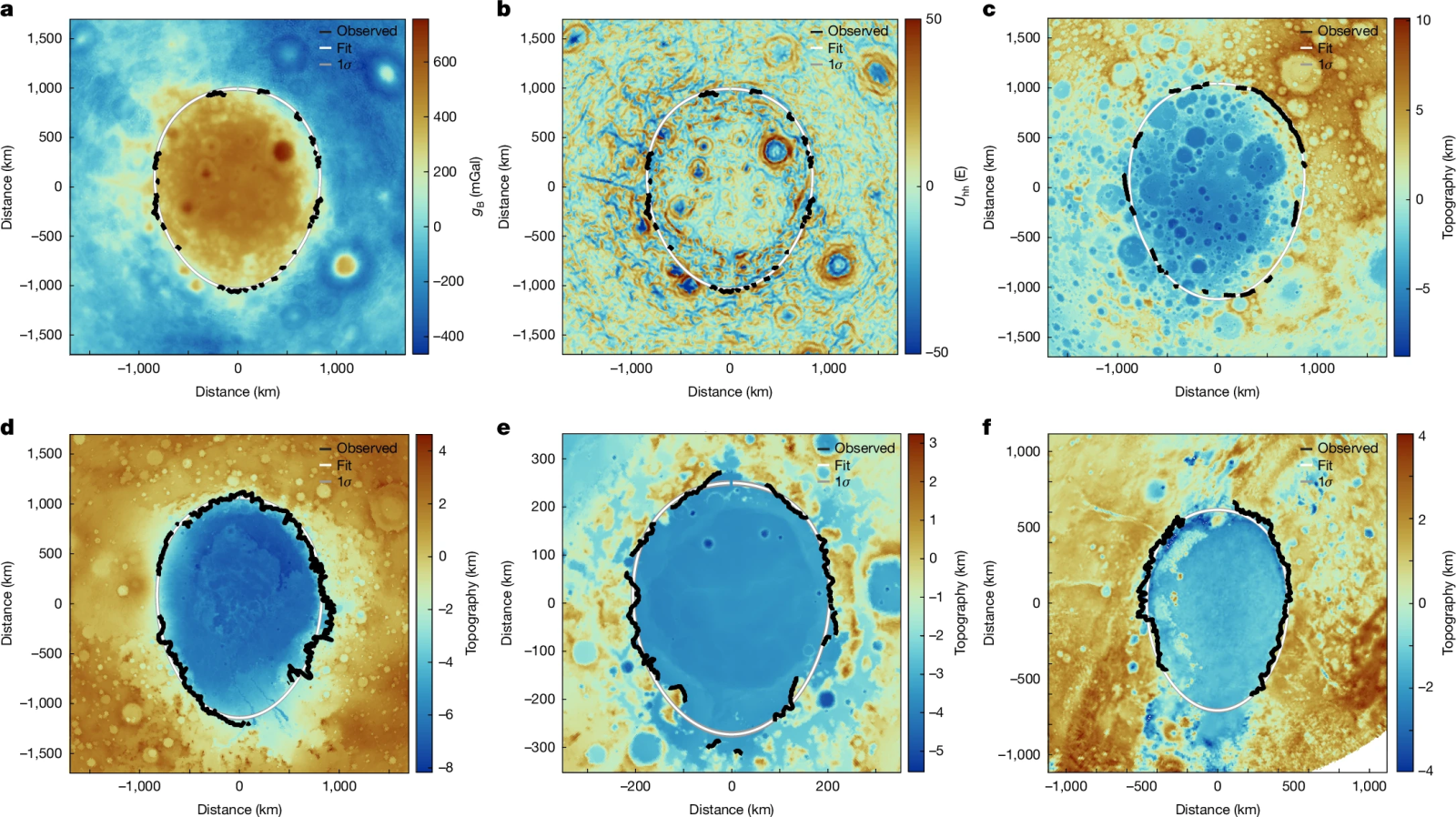Follow us on Google News (click on ☆)
This geological reassessment is not just an academic curiosity. It directly guides upcoming human explorations, designating the southern rim of this basin as a prime destination for the Artemis III mission. Astronauts would find ejecta there, materials brought up from the lunar depths during the impact, offering unprecedented access to the Moon's primitive history.

The South Pole–Aitken impact basin, located on the far side of the Moon, formed from an impact coming from the north (towards the bottom of the image).
A debris deposit rich in radioactive KREEP elements (in bright red) is visible on only one side of the basin.
This deposit contains materials extracted from the ancient lunar magma ocean.
Artemis astronauts will land in this area, at the southern end of the basin (bottom of the image).
Credits: Jeff Andrews-Hanna / University of Arizona / NASA / NAOJ.
A geological investigation to trace the impact trajectory
Solving this puzzle required an approach combining several observation techniques. The research team used topographic analysis, mapping of gravitational field variations, and study of the lunar crust's thickness to precisely redefine the often-faded contours of the basin. This data was then compared to that of other major impact structures in the Solar System, such as the Hellas and Utopia basins on Mars, to validate the interpretive models.
The result of this investigation is unequivocal: the South Pole-Aitken basin has an oblong structure, resembling a water droplet or an avocado, that narrows significantly towards the south. This characteristic shape is the signature of an oblique impact, where the narrowest part indicates the direction in which the asteroid continued its journey after the collision. This observation contradicts the historical hypothesis of an impact from the south.

a) SPA basin represented in Bouguer gravity.
b) SPA basin represented in gravity gradients.
c) Topography of the SPA basin.
d) Topography of the Hellas basin on Mars.
e) Topography of the Crisium basin on the Moon.
f) Topography of the Sputnik basin on Pluto.
All maps are in polar projection centered on the basin, oriented downward according to the assumed impact direction. The basin rims are traced in black, with a mean ellipse (white) and its variation (gray). The contours of a and b are identical, combining both datasets.
This new trajectory, from north to south, has a direct consequence on the distribution of excavated materials. Modeling indicates that the ejecta, debris thrown from the deep layers, mainly accumulated on the "downstream" rim of the crater, that is, to the south. This prediction positions the future Artemis landing zones in an exceptional geological location, on top of a pile of materials originating from the lunar mantle.
An impactor that pierced the crust at the worst time
The primitive Moon was likely a ball of molten rock, covered by a vast magma ocean. As it cooled, this ocean crystallized, giving birth to the mantle and the crust. Certain chemical elements, incompatible with the forming minerals, were rejected into the residual liquid. This final geochemical "syrup," rich in potassium, rare earth elements, and phosphorus, is designated by the acronym KREEP.
The study published in Nature suggests that the South Pole-Aitken basin impact occurred at a key moment, when the last pockets of this magma ocean were not yet completely solidified. The researchers compare this process to freezing a can of soda: the water freezes first, concentrating the sugar in the last drops of liquid. On the Moon, the KREEP elements became concentrated in the ultimate magma residues, which were squeezed towards the near side by the thickening of the far side's crust, similar to squeezing a toothpaste tube.
The proof of this scenario lies in a striking chemical asymmetry around the basin. The ejecta located on its western flank are abnormally rich in thorium, a radioactive element characteristic of KREEP material. In contrast, its eastern flank is almost devoid of it. This distribution suggests that the impact opened a breach in the lunar crust precisely at the boundary where these residual magma pockets persisted, releasing part of their content to the surface.
The definitive confirmation of these hypotheses relies on the analysis of samples collected on site. The Artemis missions, by landing near the South Pole, will thus have the opportunity to bring back fragments of these thorium-rich ejecta to Earth. Their laboratory study will allow for precise dating of the impact and characterization of the composition of the last remnants of the magma ocean, offering a unique window into the Moon's earliest moments.